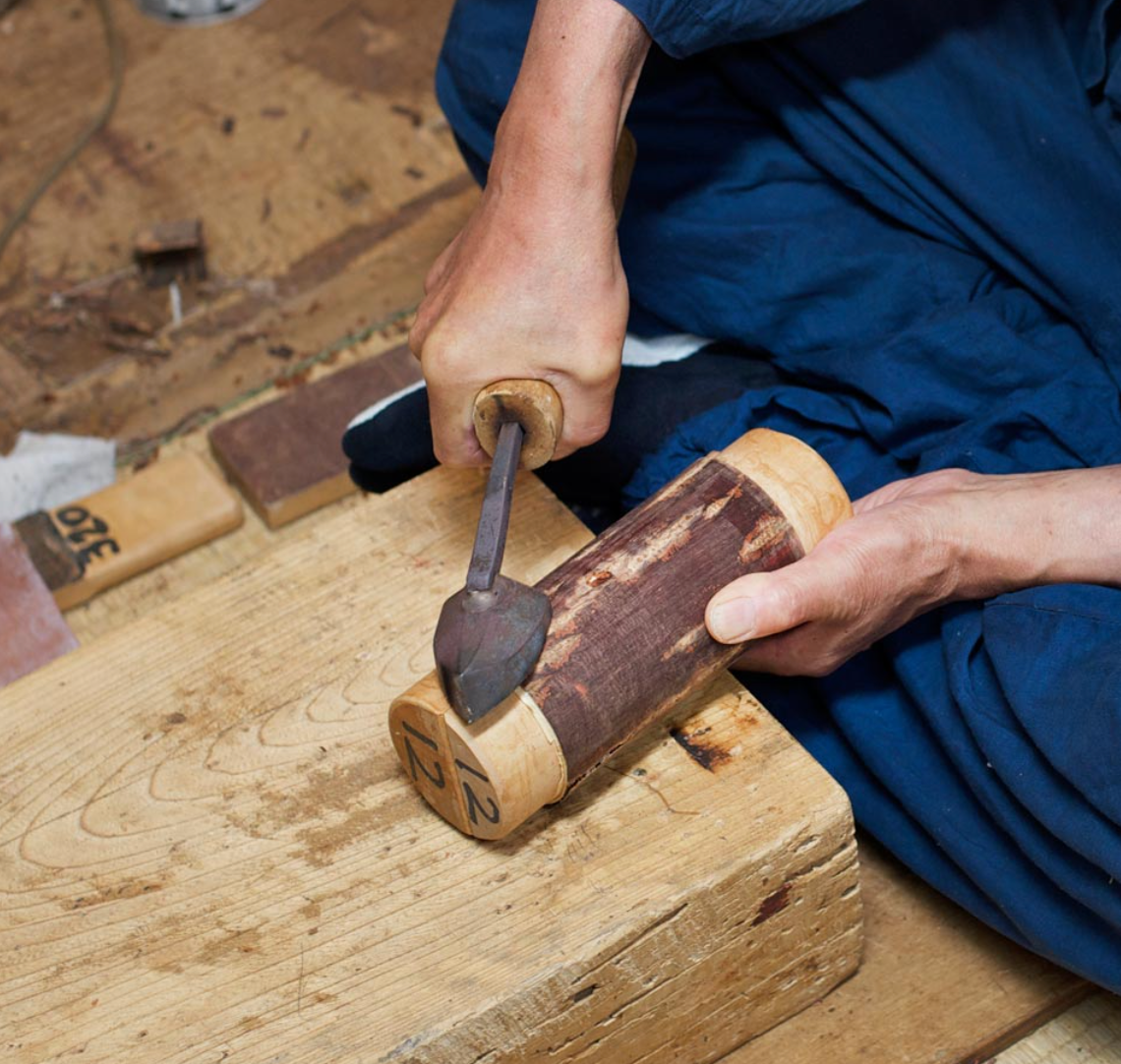茶筒は何百年もの間日本茶にとって重要なものであり、偉大な武将織田信長(1534-1582)が茶道具の美的価値を等級付けして以来、特別な威信を帯びてきました。初花、楢柴、新田と呼ばれる「天下三大茶筒」を含む茶筒は、非常に重要な文化的、政治的価値を持ち、茶筒はかつて戦場で慈悲を乞う贈り物として使われていました。偉大な武将秀吉だけが同時に三大茶筒を所有するほどの力を持っていました。これらは肩突きと呼ばれる、口が狭く肩が広い、小さくて非常に繊細な陶器の茶筒で、実際には戦国時代(1467-1615)に中国からもたらされました。
日本の伝統的な茶道(抹茶用)で用いられる茶筒は、一般的に「茶器」と呼ばれます。日本の伝統的な茶道を見たことのある方、あるいは参加したことがある方は、抹茶の粉が上品な小さな容器に入っていることに気づいたかもしれません。茶筒は、形や材質、そしてお茶を点てる種類( 薄茶または濃茶)によって分類されます。棗(なつめ)または薄茶器(うすちゃくい)と呼ばれる茶筒は、主に薄茶を点てる際に使用する抹茶を保管・提供するために使用されます。一方、濃茶を点てる際に抹茶の粉を保管・提供する陶器の器は「茶入れ」と呼ばれます。茶道には、茶筒を慎重に選び、提供する芸術性があります。茶筒は、その場で用いられる他の抹茶道具との調和を考えて選ばれるため、お客様が特に注目するアイテムの一つです。
 夏目の写真: PhotoDesignTokyoより。
夏目の写真: PhotoDesignTokyoより。
陶器の茶筒作りは、武将の時代以降も確実に受け継がれ、日本の陶工たちはその後も、そして現代に至るまで、精巧な肩突きを作り続けています。しかし、 江戸時代(1603~1868年)になると、特に貴族以外の人々の間で煎茶が人気を博し始めました。そこで日本の職人たちは、小さな陶器の茶筒作りから、主に桜や竹などの樹皮を加工し、煎茶に適した大型の茶筒を作るようになりました。
日本の茶筒工芸における第三波とも言えるものは、明治維新(1868年~)直後、イギリスから輸入されたブリキのおかげで始まりました。この新しい素材のおかげで、非常にぴったりとフィットする滑らかな円筒形の茶筒が、より多くの人々に行き渡るようになりました。同じ頃、お茶は庶民の間でもより好まれるようになり、お茶を保管するための容器(つまり、かつて使用されていた大きな茶壷に代わる容器)の需要が生まれました。 茶筒(ちゃつぼ)と呼ばれる、古くから伝わる錫の茶筒。こうした歴史的背景が、手作りの錫製茶筒の誕生につながりました。実は、この時代に八木清助氏(後述)のような職人たちが、革新的な試みを試みることに成功したのです。※なお、本記事では、より現代的な茶筒を「茶筒」と呼んでいますが、「茶筒」とは茶葉を保管するための箱、缶、瓶など、あらゆる容器を指します。
開化堂の優雅で気密性の高い茶筒への130の工程
開化堂は京都市に拠点を置く茶筒メーカーで、140年以上もの間、代々受け継がれてきた優美な手仕事の茶筒で知られています。職人の八木清助氏(初代)は、茶筒と呼ばれる新しいタイプの錫製茶筒を初めて日本人に提供しました。
日本の伝統工芸技術にも注目すべきは、まさにこの点でしょう。開化堂の伝統的な茶筒は、 130もの細心の注意を要する工程を経て作られており、今もなおその工程が受け継がれています。これらの工程は、特に日本のような湿度の高い環境で茶葉を保管する際に不可欠な気密性を保つために不可欠です。例えば、茶筒の材料を削り出す工程では、毎回同じ力加減で切ることが非常に重要です。わずかなズレでも最終的な仕上がりに影響してしまうからです。蓋と本体の直径を揃えるため、職人はそれぞれのパーツに番号を記して削り出します。歪みや反りを修正した後、丸める工程が始まります。錫板を真円にするために、「三本巻き」と呼ばれる特殊な道具が用いられます。そして、巻き上げた胴体と蓋を「八双(はっそう)」と呼ばれる専用の切り抜き道具で切り抜きます。開化堂では10人ほどの職人が分担して作業していますが、全工程を一人でこなせるのは5代目と現6代目の職人だけです。
開化堂の茶筒は、蓋が本体とぴったり合うと、まるで夕日のようにゆっくりと沈み込むように、ぴったりと収まり、ピタッと閉まるとよく言われます…。私はまだ開化堂の茶筒に触れたことはありませんが、丁寧に作られた茶筒は、上質な茶葉の鮮度と香りをしっかりと保ってくれることでしょう。開化堂の現六代目、八木隆弘さんは、たとえ失敗しても、常に心の支えである茶筒があるという信念のもと、常に新しいことに挑戦しています。その新たな試みの一つが、2016年に京都市電の洋館を改装したカフェ「 開化堂カフェ」をオープンしたことです。八木さんは、このカフェで茶筒や開化堂の未来だけに焦点を当てているわけではありません。彼の意図は、人々の日常生活に適用できる日本の伝統的な職人技を顧客に体験してもらうことです。
今日の多様化した茶筒
現代の茶筒は、種類もサイズも価格も実に多様です。開化堂のような現代の日本の茶筒の定番はブリキ製です。ブリキは鉄の表面に錫をコーティングしたもので、軽くて錆びにくいのが特徴です。金属製の茶筒には、真鍮、アルミニウム、ステンレス、銅、銀などの薄い金属が使われます。 煎茶道では錫製の茶筒が最も優れていると言われています。
日本で目にする茶筒には、陶器や木で作られたものもあります。陶器の茶筒は、陶工がろくろで挽き、窯で焼き上げます。小さな花瓶のような形をしており、底には渦巻き模様が施されています。ブリキの茶筒とは対照的に、その外観は不完全で侘び寂びのスタイルです。木製の茶筒もまた、轆轤を使って中身をくり抜いて作られる、伝統工芸の独特な形です。自然な木目を残したものや、漆で仕上げたものなどがあります。茶筒には、桜、楢、欅など、さまざまな種類の木材が使用されています。
秋田県を拠点とする藤木伝四郎さんは、樺細工を専門に手がける会社です。この会社は開化堂よりも少し前(1851年)に樺細工の問屋として創業し、その後、6代目当主の藤木幸一さんによって樺細工の製造工房へと転換しました。Yunomiで取り扱っている桜皮茶筒(下の写真)も非常に美しく、その精巧な職人技は称賛に値します。また、藤木さんは2009年からデザイナーの山田嘉一郎さんと共同で、都会のマンション暮らしにも合う現代的な茶筒の開発に取り組んできました。そこで生まれたのが、桜皮に加え、桜、メープル、クルミなどの木材を使った茶筒「和筒」シリーズです。

Sachiko さんは Yunomi で樺細工の芸術についてより詳しく書いています。このタイプの茶筒や工芸全般に興味があるなら、彼女の投稿が興味深いかもしれません。
お茶と茶筒の現代的用途を超えて
今日、日本の茶筒は茶葉の保存に使われていますが、その用途はより多様化しています。意外に思われるかもしれませんが、茶筒は唐辛子、生豆、パスタ、ハーブなど、乾燥食品の保存にも適しています。もちろんタッパーウェアで密封することも可能ですが、素材の性質上、光は透過しやすいです。そのため、茶筒は光に当たらずにしっかりと密閉できるため、メイソンジャーと同様に優れた保存容器として機能します。ただし、注意すべき欠点は、中身をマスキングテープでラベル付けするか、中身を覚えておく必要があることです。現代の茶筒は、本来の茶葉の保存用途として高く評価されていますが、茶筒と日本の伝統工芸の進化と変遷を見るのは刺激的です。
最後に、Yunomiスタッフの茶筒の使用状況について行った非公式な調査で、少々残念ではあるものの、意外ではない発見(笑)を皆さんにお伝えしたいと思います。私たちは10名という少人数のグループで、無作為抽出ではないため、もちろんこの調査を日本人全体に一般化することはできません。しかし、全体的に見ると、スタッフの半数以上が自宅に茶筒を持っていないようです。他のスタッフは複数持っています。私の家では、抹茶用(茶筒を中に巻き込んだ状態!)、ほうじ茶と寒茶用にそれぞれ1つずつ、そして豆茶用の茶筒がもう1つあります。Yunomiの創設者であるイアン・チュン氏も自宅に茶筒を持っていますが、彼はお茶をオリジナルの茶筒に入れて保存することを好んでおり、これは日本人の一般的な習慣だと思います。彼は、来客時に食卓に出す茶筒があると便利だとおっしゃっていました。伝統的、あるいは高品質な茶筒があれば、会話が弾んだり、茶の間(茶の空間と雰囲気)を感じさせたりするかもしれません。興味深いことに、茶筒は日本人の大多数にとって日常生活ではあまり使われないにもかかわらず、贈り物として贈られ、また贈られることが今でも続いています。これは、茶筒が格式、文化的、そして政治的な価値を持つという歴史的ルーツに由来しているのではないかと考えさせられます。
 Yunomiスタッフが愛用する茶筒。左: 奥村製罐の和紙入り茶筒。片方はほうじ茶用、 もう片方は煎茶用。右:茶筒そのものを持たず、元々は他のお茶を入れるための長方形の茶筒に日本茶やティーバッグを入れている方もいらっしゃいます。皆さんはどのようにお茶を保管していますか?
Yunomiスタッフが愛用する茶筒。左: 奥村製罐の和紙入り茶筒。片方はほうじ茶用、 もう片方は煎茶用。右:茶筒そのものを持たず、元々は他のお茶を入れるための長方形の茶筒に日本茶やティーバッグを入れている方もいらっしゃいます。皆さんはどのようにお茶を保管していますか?
関連リンクと記事:
- 開化堂: https://www.kaikado.jp/english/
- 開化堂カフェ: https://www.kaikado-cafe.jp/
- 藤木伝四郎: https://denshiro.jp/
- Yunomiの茶筒コレクション
注目画像:樺細工における茶筒の筒を作る技法の一つ( 「型物」と呼ばれる)。写真では、職人が桜皮と木を幾重にも重ねて接着している様子が見られます。筒状の木型に巻き付け、高温のコテで焼き付けて接着します。茶筒のすべてのパーツが一つの筒から作られているため、高い気密性を実現しています。撮影:藤木伝四郎
茶筒について何か他にご意見やご質問がありましたら、ぜひ下記にコメントやご質問を投稿してください。または、私(Moé Kishida)まで直接ご連絡ください:moe@yunomi.life。お読みいただきありがとうございました!


